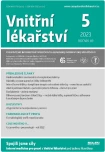Diabetes
We recommend


How Does Empagliflozin Stand in Terms of Diabetic Retinopathy Risk? We Have Answers Not Only from Controlled Studies but Also from Real Practice
Modern antidiabetics – gliflozins and glucagon-like peptide-1 receptor agonists (GLP-1RA) – significantly help improve the management of type 2 diabetes (DM2). In addition to reliable glycemic control, they offer other benefits. For example, gliflozins are known for their cardio- and renoprotective properties. GLP-1RA also reduce cardiovascular (CV) risk, though clinical evaluation (SUSTAIN-6) suggests a possible higher risk of retinopathy. This is also being investigated with gliflozins. How empagliflozin fares in this respect has been…

The Significance of Administering Gliflozins in Real Practice in Diabetics Without CV and Renal Disease
Current care standards recommend the use of sodium-glucose cotransporter 2 inhibitors (SGLT2i,…

Benefit of Empagliflozin in Patients with Chronic Kidney Disease – Results of the EMPA-KIDNEY Study
The sodium-glucose cotransporter 2 inhibitor (SGLT2i) empagliflozin is currently used to treat type…
Articles on this topic

Cardiovascular Benefit of SGLT2 Inhibitors Confirmed
The cardiovascular (CV) benefit of SGLT2 inhibitors in type 2 diabetics, demonstrated by empagliflozin...

Impact of Oral Antidiabetics on Heart Failure
Diabetes mellitus is primarily perceived as a risk factor for ischemic heart disease and general...
Subscribe
E-courses on this topic
Most read on this topic
Journal on this topic
Related topic
E-courses on this topic
Most read on this topic
- 10 Properties and Benefits of Gliptins: How They Work and When to Prescribe Them
- Gliflozins in the Treatment of Type 2 Diabetes According to Current Recommendations SVL
- How Diabetes Shortens Life or Mortality of Patients with Type 2 Diabetes
- Prescription Restrictions on Antidiabetics Authorized for Prescription by General Practitioners - Status as of October 2020
- What a General Practitioner Needs to Know About Gliflozins
- Mechanisms Connecting Diabetes Mellitus and Obesity
Journal on this topic
Related topic




